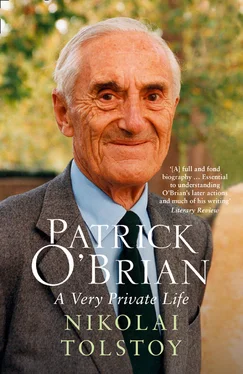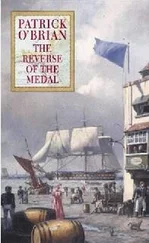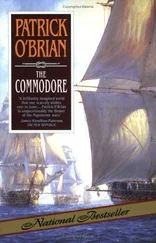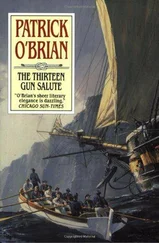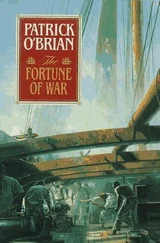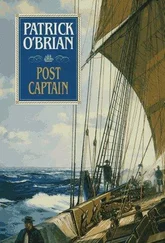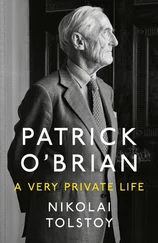The bleak Welsh winters no longer proffered an invigorating challenge, but exerted a dampening gloom permeating the little household. By the early summer of 1949, the young couple fastened on the south of France, as refuge from the more and more desperate impasse into which Patrick found himself driven. He returned from an exploratory expedition with the exciting news that he had discovered the ideal spot where they could rebuild their lives.
The little town of Collioure lies on the Mediterranean coast, a few miles from the Spanish frontier. Years later, in his broadly autobiographical novel Richard Temple , Patrick provided a vivid sketch of the impression it first made on him:
The village stood on a rocky bay, with a huge castle jutting out into the middle, and a path led round underneath this castle to a farther beach and farther rocks … A jetty ran out at the end of the second beach … and as he walked along the jetty … he took in a host of vivid impressions – the brilliance of the open sea, white horses, the violet shadows of the clouds. From the end of the jetty the whole village could be seen, arranged in two curves; the sun had softened the colour of the tiled roofs to a more or less uniform pale strawberry, but all the flat-fronted houses were washed or painted different colours, and they might all have been chosen by an angel of the Lord … the high-prowed open fishing-boats were also painted with astonishing and successful colours: they lay in two rows that repeated the curves of the bay, and their long, arched, archaic lateen yards crossed their short leaning masts like a complexity of wings.[2]
The couple arrived at the town in the beginning of September, which is generally one of the best months of the year on the Côte Vermeille. Tourists had departed, and the little town reverted to its workaday existence. The brilliant sunshine was tempered by a pleasant freshness in the air, with the Pyrenees looming behind the town standing out sharp and clear against a pure azure sky.
During his prefatory visit Patrick had already made a few friends. Among these was a beautiful Colliourencque [fn1] (as the town’s female inhabitants are termed), Odette Boutet. Odette was married to a sculptor and painter named François Bernardi.[fn2] They met again the day after Patrick’s return with my mother, when the two couples immediately became fast friends. During his initial visit Odette had helped Patrick find a small apartement on the second floor of 39, rue Arago,[fn3] situated opposite a great gateway opening through the town wall onto the seafront. There was a living room, bedroom, a windowless nook known as ‘the black hole’, a bathroom with shower, and a tiny lavatory.
Always hospitable to a fault, when guests came to stay my parents customarily abandoned the bedroom, ensconcing themselves on lilos, inflatable mattresses, in the black hole. Electricity only arrived in the apartement nine months after their arrival. Inadequate heating was initially provided by a small bottled-gas cooker, and it was not until towards the end of 1953 that they managed to afford ‘a beautiful blue enamelled stove, a flexible desk-light for P. & various other things … Very pleased with stove. It was too heavy for P & me but P & Rimbaud managed.’ This was the Mirus, a handsome and extremely effective heater, capable of burning coal or wood. Cooking was conducted on a small ‘Wonder Oven’, operating on bottled gas.
Apart from the inevitable proliferation of tourist shops and restaurants and the regrettable removal of cobblestones from the streets, the appearance of Collioure within its town walls is not greatly changed since my parents first lived there. Most streets are so narrow that the inhabitants might almost touch hands from opposite windows. Behind the rue Arago, clustered houses along winding passages ascend the hillside to the base of Fort Miradou, while a couple of streets away the Place de la Mairie provided a pleasant refuge under the shade of its plane trees, where townspeople strolled and gossiped in the evenings.
In one major respect, however, Collioure has changed beyond recognition. Some time ago, when I was discussing the town with an old family friend, widow of a retired Colliourench fisherman, she described the new Musée de Collioure in the Faubourg. It contains many pleasing relics of former local life: fishing gear, old photographs, household implements, and so forth. ‘But one aspect it can never show,’ Hélène Camps observed emphatically, ‘is the incessant and extraordinary noise we all knew in those days’ – whether inside or outside the town. For many years all coastal road traffic to Spain passed through the heart of Collioure. Eventually this came to be diverted inland through a massive road tunnel constructed beyond the railway line.
In 1954 Patrick wrote this lively description for the American magazine Homes and Gardens :[fn4]
Where the foothills of the Pyrenees plunge directly to the sea, the smooth-rounded Mediterranean sea that has bitten away the land in black cliffs there, the road winds and winds interminably: hair-pin bends writhe down to the gaunt bridges that stand over naked, dried up river-beds, and from each ravine the road twists upwards through cuttings in the red-black rock to the narrow back of the hill – up, and down again. It is a nightmare for a nervous driver in a hurry, for the lorries from Port Vendres, the buses and the cars tear furiously round the corners – blind corners – screaming brutally with their tyres, klaxons, horns. They all disregard the most elementary precautions (no Latin soul should ever drive a car) and a stranger might well demand whoever had established the theory that the French drive on the right side of the road.
But in the autumn, when the tide of summer cars has slackened, and before the schooners from the south have begun to bring up the oranges that load the lorries in the port, then one can walk safely on the road, follow its turning through the hills and look with tranquillity on the sea below or up to the mountains on the right hand.
This is the time of the vendanges. The hills, terraced with inconceivable labour to the height of the fertile land, are covered everywhere with vines, and the vines are ready.
Although families native to Collioure still live in and around the town, many houses and flats now sadly belong to absentee owners, a proportion of whom I understand do not even appear for some eleven months of the year. In contrast, Collioure in the Forties and Fifties was overwhelmingly home to Colliourench fishermen and their families. Most were closely interrelated through marriage, with links in many cases extending back for centuries. An unfortunate consequence of this was a never-ending spate of raucous conversations conducted throughout the day and much of the night, not only within the houses, whose windows for much of the year were opened wide to the mild air, but also between relatives or neighbours living on opposite sides of the narrow streets. My mother, who might have felt herself back in the Devonshire fishing village of her childhood, was able to tolerate this with fair equanimity. For the edgy and introspective Patrick, however, the hurly-burly proved a constant trial of his temper. His ears were jarred by hoarsely jocose cries of fishermen, high-pitched exchanges between wives and daughters, and maddening screams from their children. ‘Everyone evidently assumed everyone else was deaf,’ he once remarked to me.
Rare objections to the cacophony achieved little more than to exacerbate it:
Last night the Puits [the restaurant on the ground floor] made such a din: Mme R[imbaud]. told me Franco it was who threw the bottle last year: Pilar told her today. P[ilar] & F[ranco] keep cailloux [pebbles] on their window-sill.
Читать дальше
